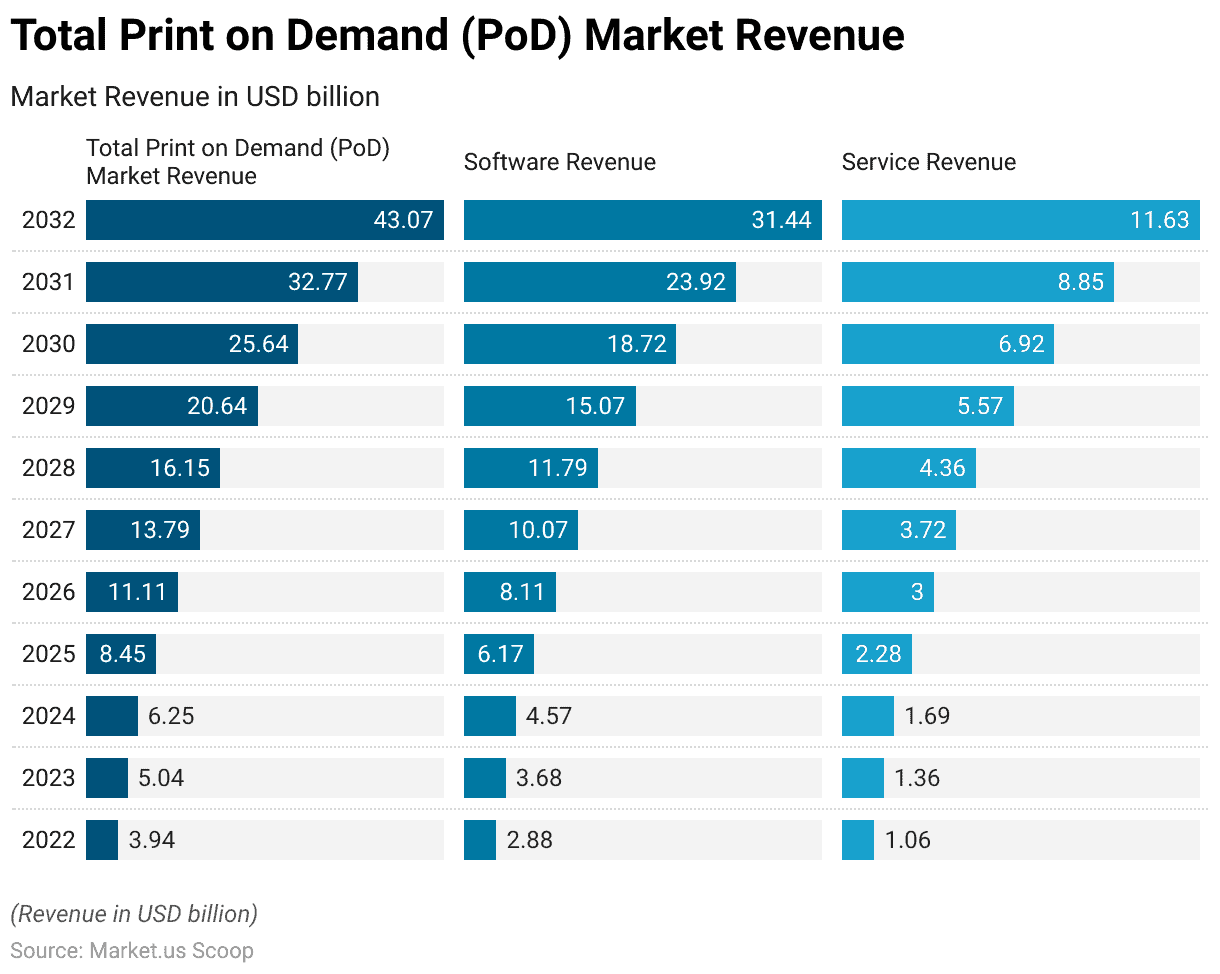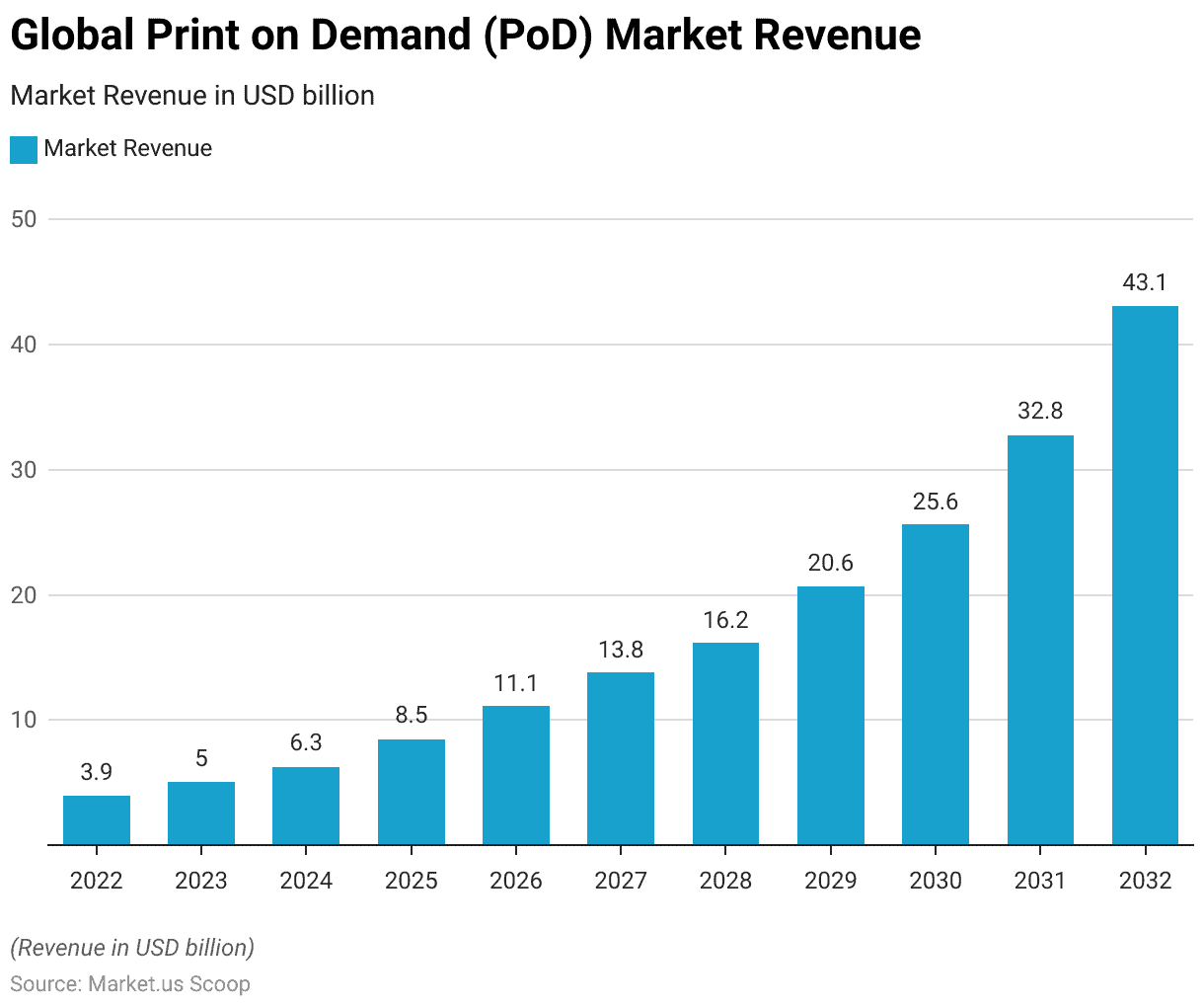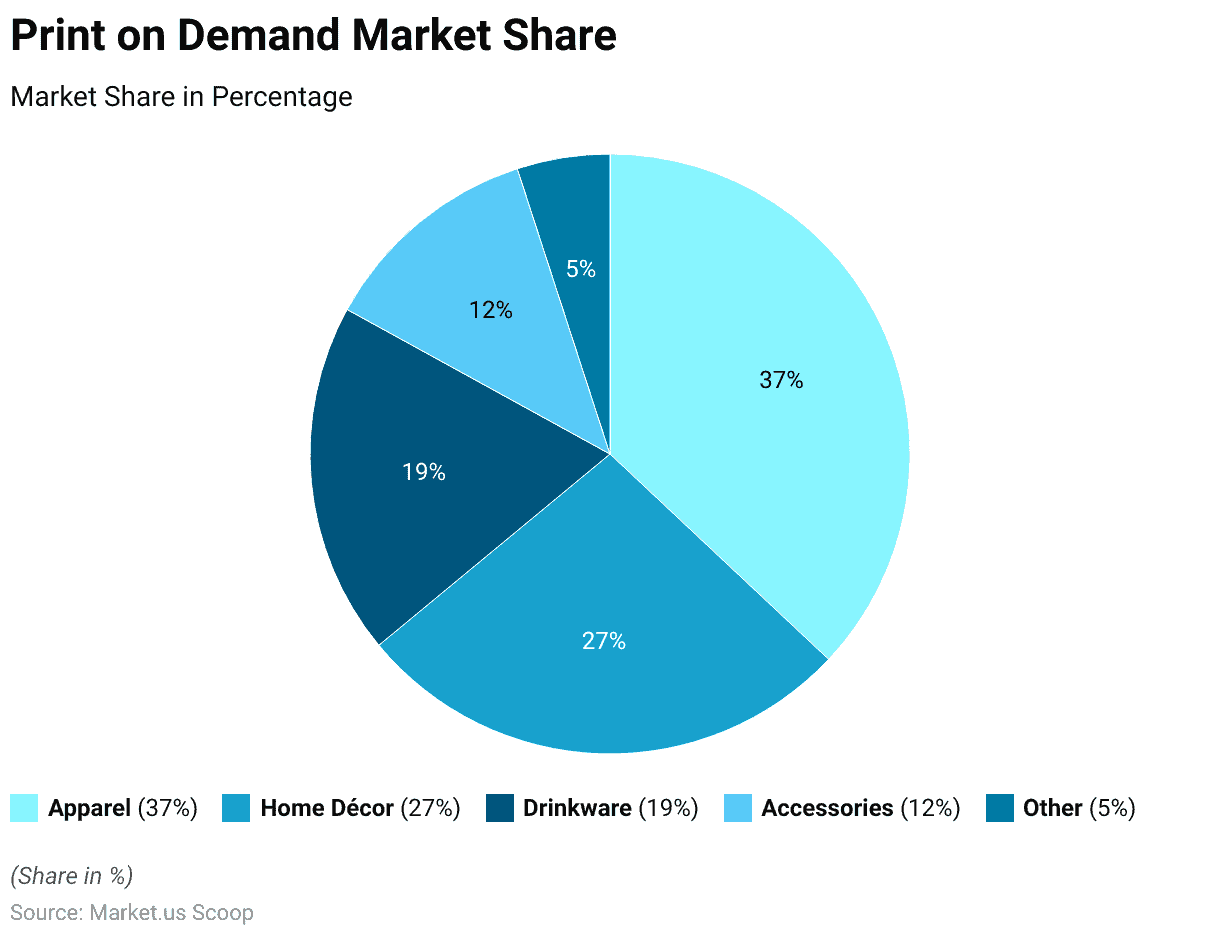Table of Contents
Introduction
Print-on-Demand Statistics: The Print on Demand (PoD) industry is growing rapidly thanks to the rise of online shopping. A desire for personalized products, and improved printing technology.
PoD enables businesses to create custom items based on individual orders, particularly in categories like clothing, home decor, and accessories. The market is competitive, with both established and new companies providing e-commerce platforms that include PoD services.
Consumers are attracted to PoD for its distinct and personalized products, and the industry’s future seems bright as it adapts to changing consumer preferences and continues to innovate.

Editor’s Choice
- The revenue in the global Print on Demand (PoD) market has exhibited a significant upward trajectory at a CAGR of 27.8%.
- In 2022, the PoD market recorded a revenue of approximately USD 3.94 billion.
- By 2023, the market is projected to reach USD 5.04 billion. With software revenue at USD 3.68 billion and services at USD 1.36 billion.
- Among the product categories, apparel commands the largest share, accounting for 37% of the market.
- Approximately 36% of consumers now expect some level of personalization as a default option and are even willing to wait longer for customized items (48%).
- In 2021, the global web-to-print software market reached a valuation of $1.187 billion.
- In 2022, Printful expanded its offerings by partnering with Patternbank. Granting customers access to a diverse selection of more than 500 fashionable and ready-to-print designs.

Print-on-Demand Market Statistics Overview
Global Print-on-Demand Market Size Statistics
- The revenue in the global Print on Demand (PoD) market has exhibited a significant upward trajectory at a CAGR of 27.8%.
- Starting in 2022, the PoD market recorded a revenue of approximately USD 3.94 billion. This initial figure marked the foundation for subsequent growth in the industry.
- As we moved into 2023, there was a noticeable uptick in revenue, reaching USD 5.04 billion.
- The momentum in revenue growth continued in the following years. In 2024, the PoD market reached USD 6.25 billion. Showing that businesses and consumers were increasingly turning to on-demand printing solutions.
- This trend persisted, with the market surpassing USD 8.45 billion in 2025, and then expanding to USD 11.11 billion in 2026.
- The subsequent years, from 2027 to 2032, continued to witness impressive revenue growth. In 2027, the PoD market revenue reached USD 13.79 billion, demonstrating a strong market presence.
- By 2028, the market exceeded USD 16.15 billion, underscoring its resilience and appeal to a broad spectrum of industries.
- Looking ahead, the PoD market appears to have a promising future. Projections indicate that by 2029, it is expected to generate approximately USD 20.64 billion in revenue, and by 2030, it could surpass USD 25.64 billion.
- The upward trajectory remains consistent, with revenue estimated to reach an impressive USD 32.77 billion in 2031 and an even more remarkable USD 43.07 billion in 2032.
(Source: Market.us)

Global Print-on-Demand Market Size- By Platform Statistics
- The Print-on-Demand (PoD) market has witnessed remarkable growth from 2022 to 2032, with consistent year-over-year increases in total market revenue. In 2022, the market was valued at USD 3.94 billion, with software revenue accounting for USD 2.88 billion and services contributing USD 1.06 billion.
- As we move forward, the PoD market is expected to experience exponential growth. By 2023, the market is projected to reach USD 5.04 billion. With software revenue at USD 3.68 billion and services at USD 1.36 billion.
- Looking ahead to 2024 and beyond, the PoD market is set to continue its upward trajectory. By 2025, the market is estimated to be worth USD 8.45 billion. With software revenue growing to USD 6.17 billion and services reaching USD 2.28 billion.
- The years 2026 to 2032 represent a period of substantial expansion in the PoD market. By 2026, the market is anticipated to surpass the USD 11 billion mark. With software revenue at USD 8.11 billion and services at USD 3.00 billion.
- The projections for 2027 to 2032 are even more promising, with the PoD market reaching USD 43.07 billion by 2032. Software revenue is expected to soar to USD 31.44 billion. While services are projected to contribute USD 11.63 billion to the market’s overall revenue.
(Source: Market.us)

Print-on-Demand Market Share- By Product Statistics
- The global Print-on-Demand (PoD) market exhibits a diverse distribution of market share across different product categories.
- Among these categories, apparel commands the largest share, accounting for 37% of the market.
- Home decor follows closely, capturing a significant 27% share, reflecting the growing trend of personalized interior design.
- Drinkware products, including customized mugs and glasses, contribute 19% to the PoD market share. While accessories, such as custom phone cases and bags, make up 12% of the market.
- The remaining 5% is attributed to a variety of other products within the PoD sector.
- This distribution underscores the versatility of the PoD industry. Catering to a wide range of consumer preferences and customization needs across various product segments.
(Source: Market.us)

Global Print-on-demand Market Drivers Statistics
- Firstly, there’s a rising demand for personalized and unique products. Approximately 36% of consumers now expect some level of personalization as a default option and are even willing to wait longer for customized items (48%).
- PoD’s advantage lies in its ability to create made-to-order products with no minimum requirements. Enabling the fulfillment of orders for even a single product with a specific design. This addresses the increasing desire for personalization while maintaining profitability.
- Another driving force is the shift from traditional retail to e-commerce, a shift accelerated by the pandemic.
- In 2021, e-commerce accounted for 18.8% of global retail sales, a figure that grew to 19.7% in 2022 and is projected to reach 24% by 2026, marking a substantial 6% increase in just four years.
- Furthermore, the emphasis on sustainability and eco-friendly products has played a significant role. A 2021 survey revealed that 27% of respondents had tried new sustainable products in the past year. With 25% increasing their spending on sustainable fashion.
- Currently, 73% of millennials are willing to pay extra for sustainable brands, and the eco-friendly clothing segment is forecasted to reach $1.57 billion in global annual sales by 2025.
- This sustainability-driven consumer behavior has further propelled the growth of PoD, particularly in the eco-friendly product niche.
(Source: Statista, TheRoundup)
The Impact of COVID-19 on Print-on-demand Statistics
- The impact of COVID-19 brought about significant changes in both personal lives and various industries. This compels us to adapt to new realities amidst uncertainties, both professionally and personally.
- One notable response to this uncertainty was the upsurge in people turning to side hustles as a means to enhance their financial security.
- In 2020, there was a remarkable 42% increase in new business startups in the United States.
- This shift can be attributed in part to the widespread layoffs during the pandemic. With a substantial 56% of Americans expressing a preference for self-employment over traditional employment as it felt more secure.
- In terms of numbers, 34% of Americans were engaged in side hustles in 2020. A figure that escalated to 40% by 2022.
- Demographically, side hustles found the most popularity among the younger generations, particularly Gen Z and Millennials.
- Furthermore, there’s a growing trend towards incorporating automation into the management of side hustles.
- Approximately 65% of Americans involved in side hustles utilize automation in their businesses. With nearly half of them (48%) relying on it for at least half of their business operations.
- Remarkably, around 14% of these individuals depend on automation for the entirety of their business processes.
(Source: CNBC, MBO Partners, Zapier Reports)
Web-to-print Industry Statistics
- Web-to-print, also referred to as online printing, is a business model that has been steadily gaining popularity.
- This approach entails the sale of printed goods via online platforms. The industry’s expansion has been remarkable, particularly with the advent of e-commerce and digital payment solutions.
- In 2021, the global web-to-print software market reached a valuation of $1.187 billion.
- The growth trajectory of the global web-to-print market stands at 7.4%, and it is projected to reach an estimated value of $1.968 billion by the year 2028.
(Source: Booklets Print)
Printful Company Statistics
- Printful maintains its dedication to embracing cutting-edge technologies. In November 2022, Printful showcased its forward-thinking approach by incorporating Sweden’s Coloreel’s instant thread color unit (ITCU), revolutionizing embroidery with limitless color choices.
- Within Printful’s portfolio of best-selling products, t-shirts, and sweatshirts hold a dominant position in the apparel category. While mugs and posters enjoy popularity in the home & living category.
- Furthermore, in 2022, Printful expanded its offerings by partnering with Patternbank. Granting customers access to a diverse selection of more than 500 fashionable and ready-to-print designs.
- In addition to this, Printful enhanced its e-commerce integration by introducing 3D product models tailored for Shopify-based online stores in 2022.
- When it comes to investment, Printful’s unwavering commitment is evident. In 2021, it allocated a substantial $32.4 million exclusively for printing equipment and technology. Contributing to an overall investment of $83.8 million thus far.
- Diversifying its product range, Printful introduced an impressive array of over 70 new products in 2021. Expanding its catalog to offer a wide selection of more than 300 options accessible to customers globally.
- Noteworthy is Printful’s exceptional growth in its enterprise-level customer segment during 2021, achieving an impressive 115% increase. This growth paved the way for strategic partnerships with well-known brands such as Coca-Cola, MTV, and Comedy Central in recent years.
- From a financial standpoint, Printful’s revenue in 2021 exceeded the remarkable milestone of $289 million. Marking a substantial 39% surge compared to its 2020 revenue of $208 million.
(Source: Printful)
Recent Developments
Acquisitions and Mergers:
- Shutterfly Acquires Snapfish: In early 2023, Shutterfly, a leader in personalized photo products, acquired Snapfish for approximately $200 million. This merger aims to enhance its print-on-demand capabilities and expand its customer base, leveraging Snapfish’s technology and resources.
- Vistaprint Acquires Printful: In a strategic move in mid-2023, Vistaprint announced the acquisition of Printful, a prominent print-on-demand service, for around $150 million. This acquisition allows Vistaprint to broaden its product offerings and streamline its supply chain for print products.
New Product Launches:
- Amazon Launches New Print-on-Demand Service: In January 2024, Amazon launched a new print-on-demand service called Amazon Print, allowing creators to design and sell custom merchandise directly through their platform. Initial offerings include T-shirts, mugs, and posters, aiming to tap into the growing market of independent creators.
- Blurb Introduces Expanded Format Options: In late 2023, Blurb introduced new print-on-demand options, including larger format books and custom-sized photo albums. These new products cater to professional photographers and artists looking for high-quality print solutions.
Funding:
- Printify Secures $45 Million in Series B Funding: In November 2023, Printify, a leading print-on-demand platform, raised $45 million in a Series B funding round led by venture capital firms. This funding is intended to enhance their technology infrastructure and expand global operations.
- Gooten Raises $25 Million for Expansion: In March 2024, Gooten, another major player in the print-on-demand sector, announced it secured $25 million in funding to broaden its product offerings and improve its fulfillment capabilities, aiming for increased market penetration.
Technological Advancements:
- Integration of AI in Design Tools: Many print-on-demand platforms are now integrating AI tools to simplify the design process for users. By 2024, it is anticipated that 40% of print-on-demand services will incorporate AI-driven design solutions, allowing customers to create products more efficiently.
- Sustainability Initiatives: Several companies are focusing on sustainable print-on-demand options. By 2025, 30% of print-on-demand products are expected to be made from eco-friendly materials, as consumers increasingly demand sustainable and ethically produced goods.
Conclusion
In summary, the Print on Demand (PoD) industry has experienced substantial growth due to the demand for personalized products, the shift to online shopping, and a focus on sustainability.
Various product categories, including apparel, home decor, and accessories, have found success within PoD.
Technological innovations, such as the Coloreel instant thread color unit (ITCU) and 3D product models, have enhanced customization options.
Financially, the PoD industry has thrived, with significant investments in technology, an expanded product catalog, and partnerships with well-known brands. This industry is poised for continued growth and adaptation to evolving consumer preferences.
FAQs
Print-on-demand is a business model where products, primarily customized items, are produced in response to specific customer orders, eliminating the need for pre-printed inventory.
PoD covers a wide range of products, including apparel, home decor, accessories, posters, and more. The possibilities are diverse and customizable.
PoD works by integrating an online platform where customers can select and personalize products. When an order is placed, the product is then printed and shipped directly to the customer.
Key advantages include no inventory costs, the ability to offer personalized products, low upfront investment, and the opportunity to tap into niche markets.
PoD can be eco-friendly if it focuses on sustainable practices, such as using eco-friendly materials and responsible printing processes.
Discuss your needs with our analyst
Please share your requirements with more details so our analyst can check if they can solve your problem(s)



